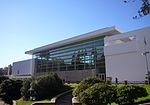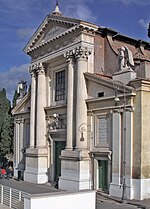Ponte Cavour
1901 establishments in ItalyBridges completed in 1901Bridges in RomeRoad bridges in ItalyRome R. IV Campo Marzio ... and 1 more
Rome R. XXII Prati

Ponte Cavour is a bridge in Rome (Italy), connecting Piazza del Porto di Ripetta to Lungotevere dei Mellini, in the Rioni Campo Marzio and Prati.The bridge also serves as a connection between Piazza Cavour and the area of Campo Marzio near the Ara Pacis. Since the postwar period, in the morning of 1 January of each year the tradition of diving into the Tiber is renewed by swimmers jumping from the parapet of the bridge.
Excerpt from the Wikipedia article Ponte Cavour (License: CC BY-SA 3.0, Authors, Images).Ponte Cavour
Ponte Cavour, Rome Municipio Roma I
Geographical coordinates (GPS) Address External links Nearby Places Show on map
Geographical coordinates (GPS)
| Latitude | Longitude |
|---|---|
| N 41.904964 ° | E 12.474385 ° |
Address
Ponte Cavour
Ponte Cavour
00186 Rome, Municipio Roma I
Lazio, Italy
Open on Google Maps











